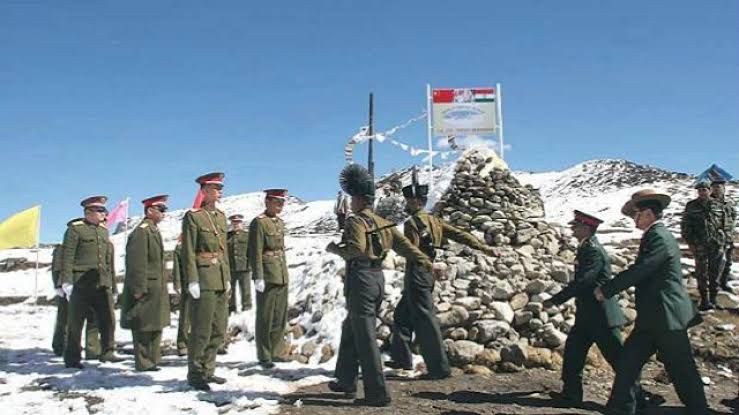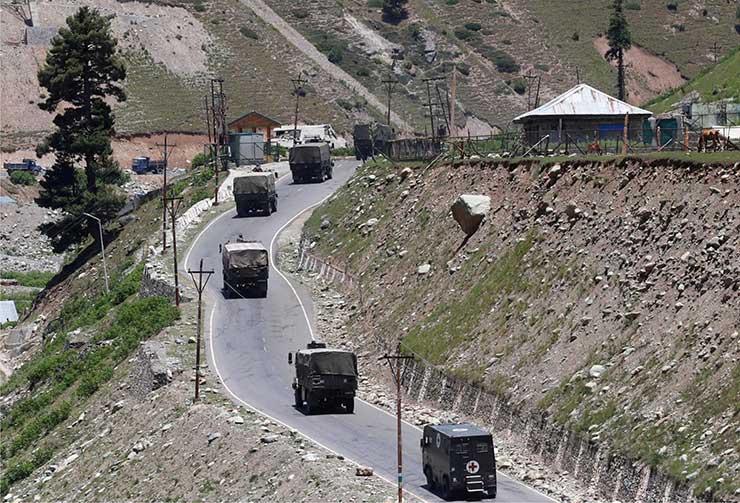
After almost eight-nine months of breathing down each other’s neck, the two giants of Asia, India and China, have agreed to disengage militarily in Eastern Ladakh. And on February 10, began the process of disengagement, spearheaded by armoured and mechanised forces. However, mutually verified disengagement is only applicable to North and South banks of Pangong Tso lake. It does not include Depsang plains, Hot Springs, Bogra and some other important areas North of Pangong Tso lake. Therefore, it is not de-escalation aimed at reducing the probability of a military conflict but a mere postponement of likely military conflict. It is not a total package of normalcy but a half bit action of dangerous pitfalls.
Now two questions do arise. First question is to analyse as to what has China achieved by initiating military aggression against India’s Eastern Ladakh? Second question is to know whether India can trust China, particularly when Damocles sword hangs over strategically important area of Eastern Ladakh i. e. Daulat Beg Oldi (DBO), just eight-ten km South East of Karakoram pass. China’s continuous heavy deployment in Depsang plains and Hot Springs area is a pincer aimed not only at DBO but also a flanking manoeuvre from the North to cut off Darbuk – Tangtse – Pangong Tso area. Therefore, India cannot rest at peace till total disengagement is achieved from all areas.
Conflicting motives have been assigned by various national and international analysts to China’s aggressive action in Eastern Ladakh. There were varying theories from imminence of war to diversionary tactics to draw away world attention, more particularly USA, from Taiwan and East China Sea. Confusion has been created by China on a simultaneous action on two fronts, namely, India in the West and Taiwan on the East. Therefore, it has been cleverly able to mask its real motive in Eastern Ladakh. To be very frank, China was looking West but talking East.
It is now felt that China was very keen to settle the issue of “One China” policy over Taiwan in the final year of Donald Trump presidency in November – December 2020. Chinese strategic thinkers were of the view that USA would be busy in Presidential elections and its transition to new administration. Thus, a quick military action would enable Xi Jinping’s military to quickly grab Taiwan. In fact on September 20, 2020, The Global Times, a Chinese government mouth piece and an English daily set the records straight, when its editorial noted, “——-PLA is ready to safeguard national sovereignty and territorial integrity, deter US interference and Taiwan secessionist forces, and, if they go too far, reunify the island by force——“
In view of the above, it is generally concluded that Taiwan was China’s first priority. To mask its intentions and to mislead USA and the world, it simulated a military conflict in Eastern Ladakh. However, it was not only a diversionary tactics but also aimed at engaging Indian military to allow Pakistan to carry out elections in Gilgit – Baltistan (GB) area of Pakistan occupied Kashmir ( POK), which India has been threatening to annex since August 5, 2019, when it had abrogated Article 370 and article 35A on Kashmir. GB is very important to China and Pakistan, as it was a not only gateway to Gwadar port in Persian Gulf but also the life line of much hyped China Pakistan Economic Corridor (CPEC).
However, deception did not pay off as USA did not buy the bait. In fact, USA apprehending Chinese military action in Taiwan immediately dispatched its two aircraft Carriers, Nimitz and Roosevelt, to East China Sea. This had upset China’s apple cart. As a face saving device, it had no other choice but to continue its deployment in Eastern Ladakh, at least till assembly elections are held in GB on November 15, 2020, which Pakistan was keen to make its fifth Province. Thereafter, China’s only aim was to fix Indian military and disallow it to interfere in GB. It was Plan B in operation.
Thus, Chinese motive in Eastern Ladakh was well masked but very limited. Precisely speaking, it was security insurance to Pakistan’s impending action in GB. Therefore, Chinese troops would keep India occupied till Pakistan had done what it had wanted to be done in GB.
However, a physical clash occurred between Chinese and Indian soldiers, in the Galwan valley on June 15, 2020, when India lost 20 of its soldiers and China also suffered unspecified heavy casualties, some say over 100. But China has never disclosed the total figure. Following this China adopted an aggressive posture towards India. But, China knew that war with India, even if it did get some success, it would not gain much dividends. In fact, it would lose in its drive to be a Global leader by 2049. It would also hurt its “One China Policy,” which aims to assimilate Taiwan with mainland China. What more world will become wary of its expansionist designs and thus raise doubts on its much hyped ONE BELT, ONE ROAD (OBOR).

All the same, China cannot be trusted because its strongman Xi Jinping is an over ambitious man. China’s pride was dented because of Galwan action on June 15, 2020. Then, occupation of Kailash Range, south of Pangong Tso lake, in August 2020 by India, had further shocked China. It had never expected India to be so aggressive and offensive. All the same, Indian actions also exposed the weaknesses in the training and mental makeup of Chinese soldiers. A Harvard university report, from USA, had pointed out that Chinese soldiers were ill-trained to fight in high altitude region. The university report rated Indian soldiers at a much higher pedestal of soldiering. It is learnt that ever since then, China had been training its soldiers for high altitude warfare in Canada. If it is true then, it is for certain, that it was a tactical withdrawal by China. It can come back with vengeance.
India must know that ‘life time chairman’ of China, Xi Jinping, would not rest till he was deposed or achieves his aim of making China the only Global power. To do so, India is a final frontier to be conquered by China. He will seek to make another bid to make India fall in line. Xi Jinping’s Fa Fen, You Wei (FFYW) Doctrine, which aims to prove one’s worth through firm resolve, it seeks to subdue one’s adversaries through offensive and aggressive actions. Ever since Xi’s rise in 2012, China has been taking an aggressive and violent path to make its neighbours unstable by intimidatory actions on the borders. It may be noted that it has a boundary with 14 countries but it has land dispute with 21 nations.
It is very important to understand China’s large stakes in GB. Not only it is an entry point of CPEC at Khunzerab pass but also it hugs adjoining region of Xinjiang province of China, which is dominated by Uighur Muslims. Should India occupy this region, not only CPEC would be threatened but it would inflame the Uighur Insurgency in Xinjiang province. What more, it would also threaten G-219 — Tibetan Highway from Kashgar in Xinjiang to Lhasa in Tibet.
GB region is also very important to China because of 3,000 km long Karakoram Highway, which is going to be China’s economic life line for trade with rest of the world. It is a new “Silk Route” of China. GB adjoins Xinjiang region of China and is very significant for China’s battle for Global supremacy. At no cost, China would allow Indian dream of re- taking of GB.
China needs water resources of GB for its now envisaged micro chip industry. Earlier China imported this from Taiwan but it has been now stopped. Therefore, it wants to start manufacturing of micro chips in Xinjiang, which adjoins GB. And micro chip production needs water extensively. In view of the needs of its micro chip industry, China has also agreed to finance and build Diamer-Bhasha Dam. It is located on the Indus River in northern Pakistan between Kohistan district in Khyber Pakhtunkhwa (KPK) and Diamer district in GB. The Dam will have a gross storage capacity of 8.1 Million Acre Feet (MAF) and power generation capacity of 4500 MW. It will be constructed at a cost of over Rs 1400 Billion Pakistani rupees.
Ladakh – GB (LGB) region obtains a very high place in Chinese strategic thinking. While it is confident of annexing Taiwan at a future date, it is LGB which would be its headache, if India is not subdued by hook and crook. While it may pressurise on the LAC, it may use ALTERNATIVE FORMS OF WAR (AFOW) to break up India internally. It will exploit internal vulnerabilities and movements, such as anti-CAA protests or Farmers Protests to weaken and destroy India.
In a 2009 article in Global Times, it was recommended that India should be broken into 20-30 states by pitching its internal contradictions one against the other. India has to move with a lot of caution in dealing with China. The hand that signed the disengagement agreement might be lacerated with a deadly virus.
-An ex-NDA and Wellington Staff College graduate, Col Rajinder Singh is a renowned author and security analyst. He has authored four books, two individually and two in collaboration. His best-selling books are Kashmir – A Different Perspective and The ULFA Insurgency. The views expressed are of the author and do not necessarily reflect the views of Raksha Anirveda








